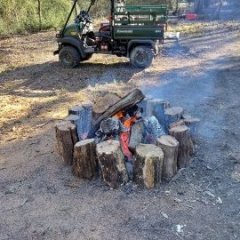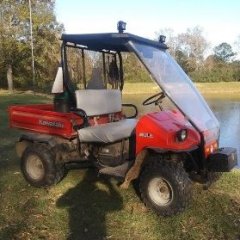diesel mule battery
-
Similar Topics
-
By didgeridoo
Hello, All! I've decided to replace the traction batteries in my 2018 Sector E1 with a 48V Lithium set. They may be expensive, but I figure the Discovery Dry Cell are, too. I am not looking for the max driving range, as I have never received near the brochured range to begin with, but a good mix of charge/ get work done/ charge is what I am expecting.
I have settled on the 48V EAGL kit from bigbattery dot com. Each battery pack provides 30Ah. The kit ships with a charger, as well. The packs would be physically connected in parallel (using a busbar) to one another, maintaining the 48V voltage, but together would be able to provide the amp draw the buggy pulls when going up hill or towing a rake (rated 320 max continuous Amps). This is in comparison to the serial connection the eight 6V lead batteries. Each of the EAGL batteries looks to have its own BMS; am I correct in thinking I will have to use their included charger rather than (simply) changing the onboard charger to lithium mode? The chemistry of the pack is LiFe PO4, for what it's worth. I haven't torn anything apart yet (to diagram), so I am not sure how the dash will interpret the AMP draw, but the kit I am looking at includes a dash mounted charge indicator.
If anyone has completed a similar conversion, do you have any tips? Specifically, how did you remove the original batteries, and how did you secure the new ones? I am guessing that almost any change from the stock batteries would involve at least some modifications. Any tips would be appreciated, especially things I may have failed to consider. Thanks!
-
By BuggyBoy
So these Giant 48v/110ah batteries have just become available: https://www.aussiebatteries.com.au/giant-100ah-48v-lithium-golf-cart-deep-cycle-battery
They look like they could drop in either side of the Controller that sits in the middle of the tray as they are 330mm(W) 355(L) 295mm(H). They can be paralleled, and I think two should be enough. Technically once paralleled the system should output 400ah continuous and 800ah Max (5 secs), more than enough for the E1 - probably 1/3rd more than is needed.
However, the sales person stated that if the regen braking exceeded 400amps, it would put the batteries in standby mode for protection and they would have to be 're-started' with a jumper pack to reset them. Does anybody know the max output of the E1 Regen system, and if it does exceed that, is it possible to disable/bypass the regen so it has a zero output?
Thanks.
-
By Joe Breaux
Everybody out riding? Awfully quiet here recently. It's so damn hot here .We expect 112 to 116 heat index tomorrow..getting too old for that heat.
-
By Travis
Many people have issues with the kawasaki FJ400 engine fouling out spark plugs, after working on a few FJ engines and 600 series Mule's with this issue, i can say the fix for this issue is using a slightly hotter spark plug... the factory recommends a BPR6ES NGK plug.... the Number in NGK plugs represents its heat range and somewhat odd, the lower the number the hotter the plug, at least as far as NGK is concerned. If you have a Mule fouling spark plugs try installing a NGK BPR4ES spark plug.
FROM NGK
A hotter heat range spark plug has an insulator design with a longer heat flow path to the metal shell of the plug. As a result, more heat stays in the ceramic firing end and less is dissipated to the engine. A colder heat range spark plug has an insulator design with a shorter heat flow path to the metal shell of the plug. As a result, less heat stays in the ceramic firing end and more is dissipated to the engine. For a spark plug to function properly, it must have a tip temperature high enough to burn off carbon deposits (self-cleaning) and avoid fouling, while remaining low enough to avoid overheating the ceramic firing end and pre-ignition.
-
By BOYD
I have a 2004 KUBOTA RTV 900 DIESEL and I need to replace both front cv axels.I have been online looking at them and there seems to be a lot of different manufactures to choose from. My question is who makes a good aftermarket set of cv axels for this KUBOTA. I have read horror stories of people buying the cheap Chinese brand only to find out they don't fit or they don't last very long and fail again. I hate to have to spend over $200 a shaft to get OEM from KUBOTA when I'm sure there is a company out there who probably makes it for them or makes comparable to OEM. Thanks for your help.
-







Recommended Posts
Join the conversation
You can post now and register later. If you have an account, sign in now to post with your account.
Note: Your post will require moderator approval before it will be visible.